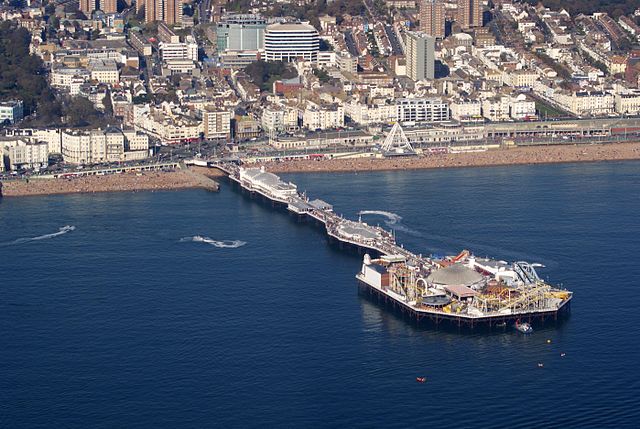The Brighton Marine Palace and Pier is a pleasure pier in Brighton, England, which opened in 1899. It is generally known as Palace Pier for short but was renamed Brighton Pier in 2000 by its owners, the Noble Organisation. In July 2016, the owners announced it would be renamed Brighton Palace Pier. The West Pier was its rival but was closed in 1975 and was subsequently severely damaged by fires and storms, with the remaining iron structure being partially demolished in 2010. Historically, the now destroyed Royal Suspension Chain Pier was the first pier structure built in Brighton.
History
Work began on the Palace Pier in 1891. The inaugural ceremony for laying of the first pile was held on 7 November 1891, overseen by Mayor Samuel Henry Soper. The pier opened in May 1899 after costing a record £27,000 to build. This was Brighton’s third pier. A condition to be met by its builders, in exchange for permission to build, was that the first, the Royal Suspension Chain Pier of 1823, which had fallen into a state of disrepair, was to be demolished. They were saved this task by a storm which largely destroyed the Chain Pier.
A concert hall opened two years later, and by 1911 this had become a theatre.
During World War 2, the pier was closed and some decking removed as a security precaution.
Summer shows with stars such as Dick Emery, Tommy Trinder and Doris and Elsie Waters were held in the theatre until the 1970s.
During a storm in 1973, a 70-ton barge moored at the pier’s landing stage broke loose and began to damage the pier head, particularly the theatre. Despite fears that the pier would be destroyed, the storm eased and the barge was removed. The damaged theatre was never used again.
In 1986 the theatre was removed, on the understanding that it would be replaced. This has not happened, and the present seaward end building looks fairly modern in comparison with the rest of the structure, supporting a domed amusement arcade and several fairground rides, including several thrill rides, children’s rides and roller coasters.
A bomb planted by the IRA near the pier in 1994 was defused by a controlled explosion.
The pier was renamed as “Brighton Pier” in 2000, although this legal change is not recognised by the National Piers Society or some of the residents of Brighton and Hove. The local newspaper, The Argus, still refers to the structure as the Palace Pier and it was finally agreed by the owners in July 2016 to change the name to Brighton Palace Pier.
The Palace Pier suffered a large fire on 4 February 2003 but the damage was limited and most of the pier was able to reopen the next day. This was a fraught period for Brighton’s piers, with much damage occurring to the West Pier (of 1866) shortly before and after this event.
In 2004 the Brighton Marine Palace Pier Company (owned by the Noble Organisation), admitted an offence of breaching public safety under the Health and Safety at Work Act and had to pay fines and costs of £37,000 after a fairground ride was operated with part of its track missing. Judge Nicholas Ainley, passing sentence at Hove Crown Court, said that inadequate procedures were to blame for the fact that nothing had been done to alert staff or passengers that the ride would be dangerous to use. As a result, the management team was replaced and began a new training programme. The company subsequently employed a full-time health and safety manager.
The pier was listed at Grade II* on 20 August 1971.[8] As of February 2001, it was one of 70 Grade II*-listed buildings and structures, and 1,218 listed buildings of all grades, in the city of Brighton and Hove.
Cultural References
The pier features prominently in the 1971 film, Carry on at Your Convenience, and it is frequently shown iconically to “set” film and television features in Brighton, for example in scenes in Mirrormask, The Persuaders, the Doctor Who serial The Leisure Hive (1980), the 1979 film Quadrophenia and the 2007 film, Sweeney Todd: The Demon Barber of Fleet Street, The End of the Affair (1999), Circus (2000), and Neil Jordan’s Mona Lisa (1986). Much earlier, from 1896 on, the pier was shown in many silent films. R.W. Paul shot the iconic film, On Brighton Beach, which included both the Palace Pier and the West Pier. Palace Pier is a novel by Keith Waterhouse, set in Brighton, and it is the setting for a scene in the Graham Greene novel Brighton Rock. The pier was also featured in Lynda la Plante’s 1998 thriller Killer Net.
The Pier is also featured in 2012 German film Schutzengel starring German actor Til Schweiger.
The 2014 novel The Bone Clocks by David Mitchell includes passages that take place on the pier.
The 2015 British TV series, Cuffs, which takes place in Brighton features the pier, both in the opening theme as well as in parts of the story lines.
Awards
1998 National Piers Society—Pier of the Year
Discover more from LandmarkLocation.com
Subscribe to get the latest posts sent to your email.


